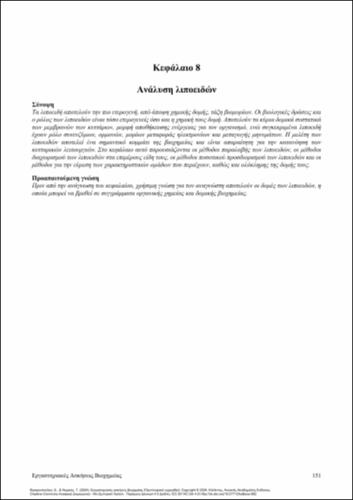| Title Details: | |
|
Lipid analysis |
|
| Authors: |
Fragopoulou, Elizabeth Nomikos, Tzortzis |
| Reviewer: |
Antonopoulou, Smaragdi |
| Description: | |
| Abstract: |
Lipids constitute the most chemically heterogeneous class of biomolecules. Their biological functions and roles are as diverse as their chemical structures. Lipids are the main structural components of cell membranes and serve as a form of energy storage for the body. Additionally, specific lipids function as coenzymes, hormones, electron transport molecules, and signaling molecules. The study of lipids is a crucial part of biochemistry and is essential for understanding cellular functions. This chapter covers the methods for obtaining lipids, separating them into individual species, quantitatively determining lipid content, and identifying their characteristic groups and overall structures.
|
| Linguistic Editors: |
Alexopoulou, Katerina |
| Graphic Editors: |
Skouloudis, George |
| Type: |
Chapter |
| Creation Date: | 27-05-2024 |
| Item Details: | |
| License: |
Attribution - NonCommercial - ShareAlike 4.0 International (CC BY-NC-SA 4.0) |
| Handle | http://hdl.handle.net/11419/13435 |
| Bibliographic Reference: | Fragopoulou, E., & Nomikos, T. (2024). Lipid analysis [Chapter]. In Fragopoulou, E., & Nomikos, T. 2024. Laboratory exercises in biochemistry [Undergraduate textbook]. Kallipos, Open Academic Editions. https://hdl.handle.net/11419/13435 |
| Language: |
Greek |
| Is Part of: |
Laboratory exercises in biochemistry |
| Publication Origin: |
Kallipos, Open Academic Editions |

